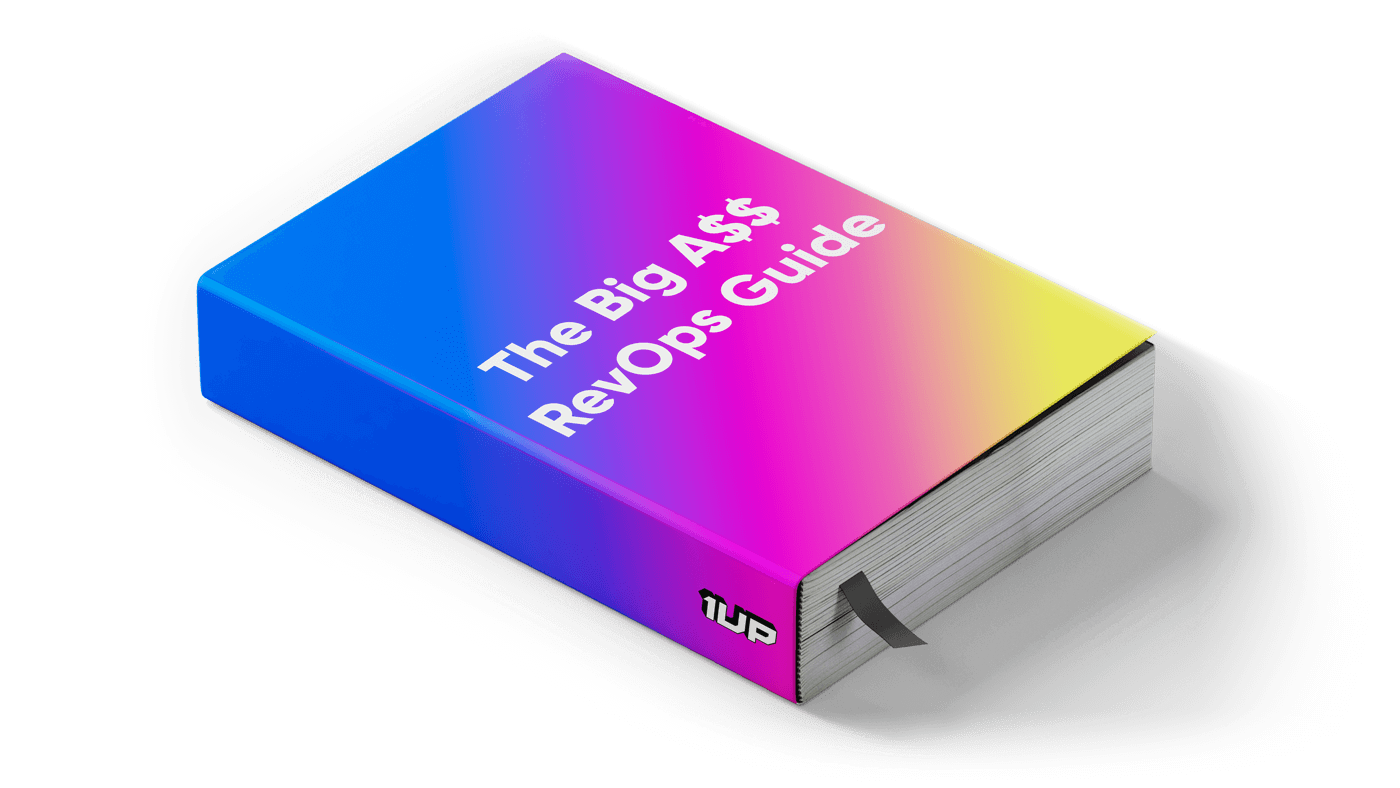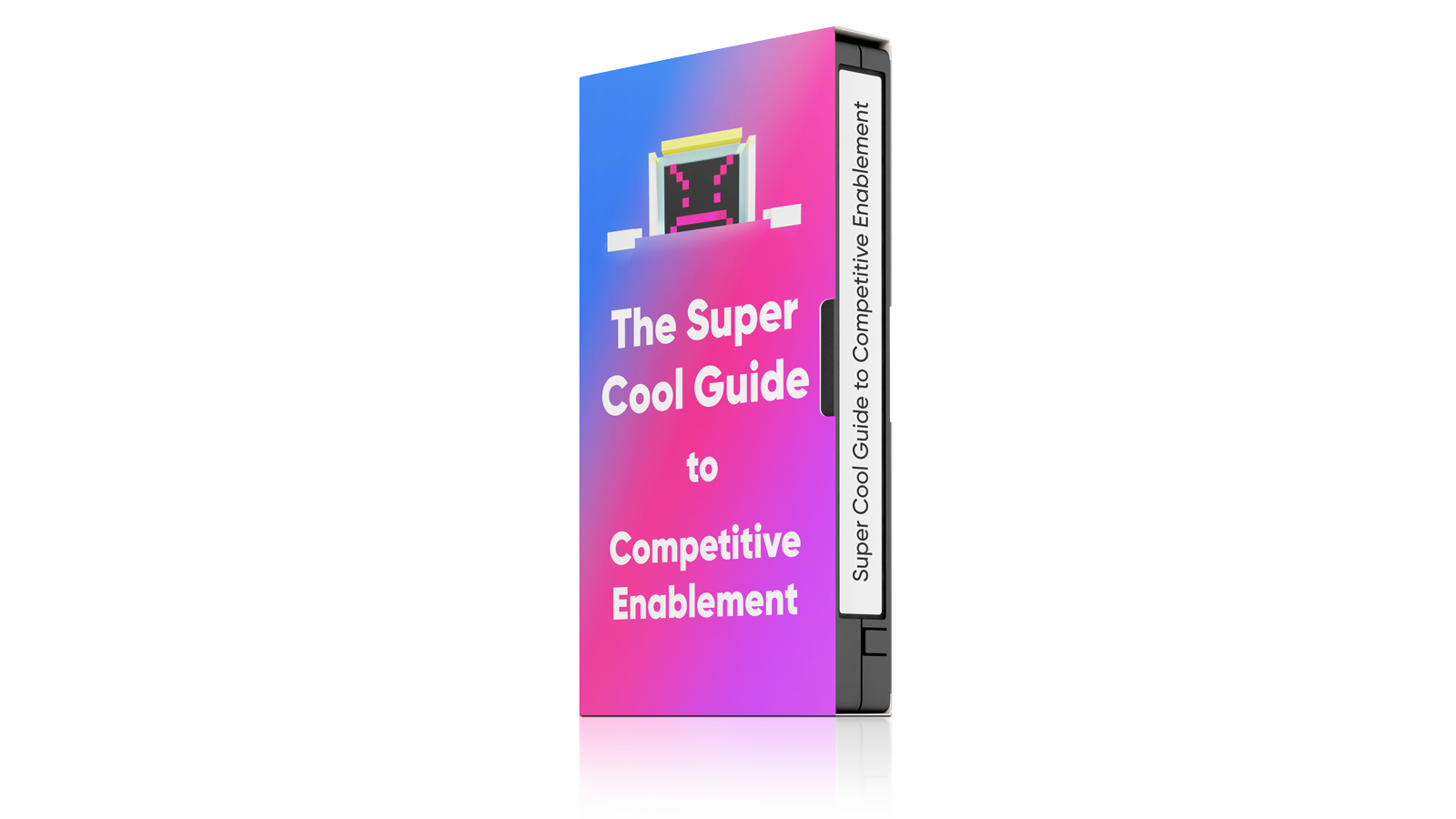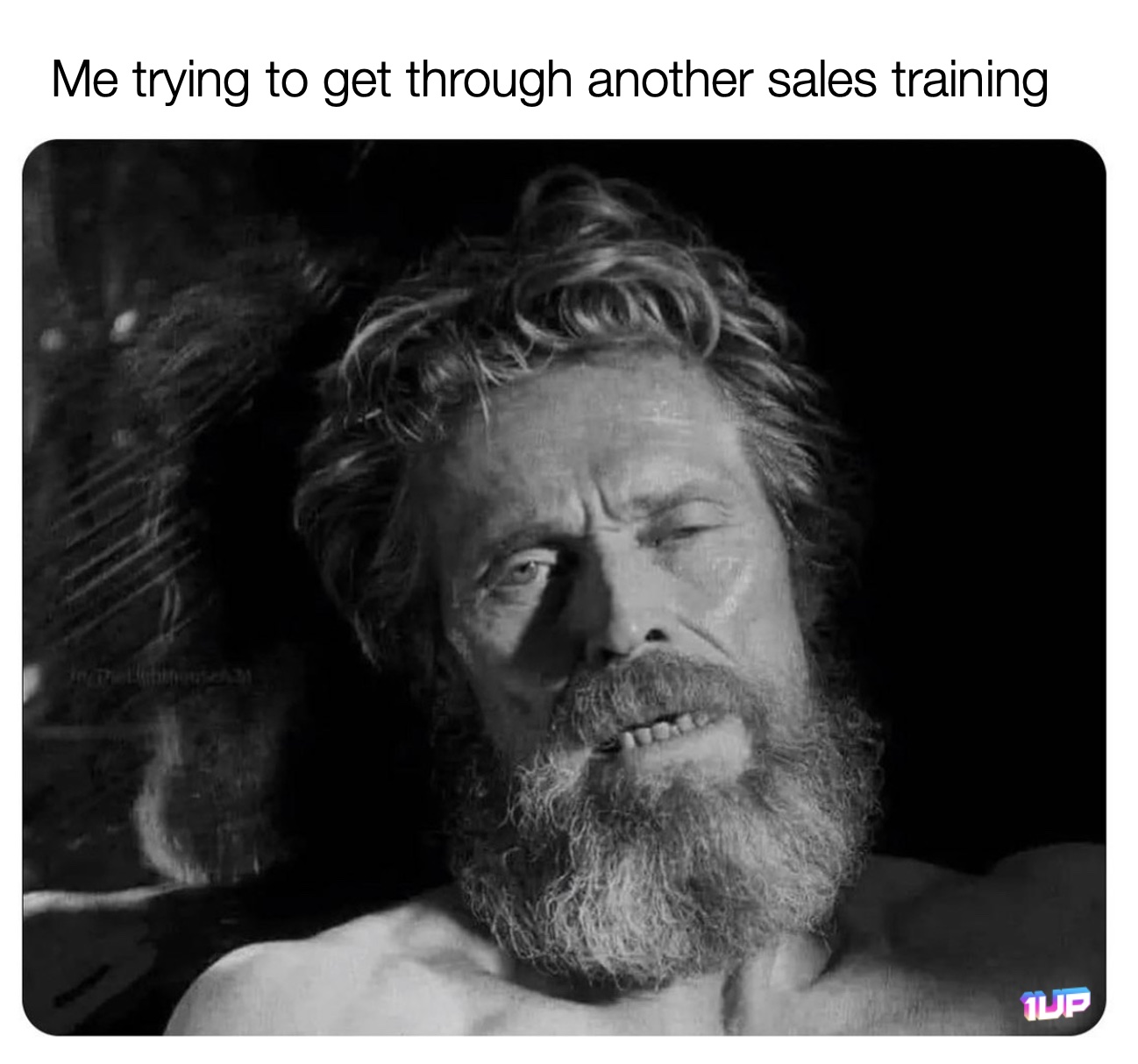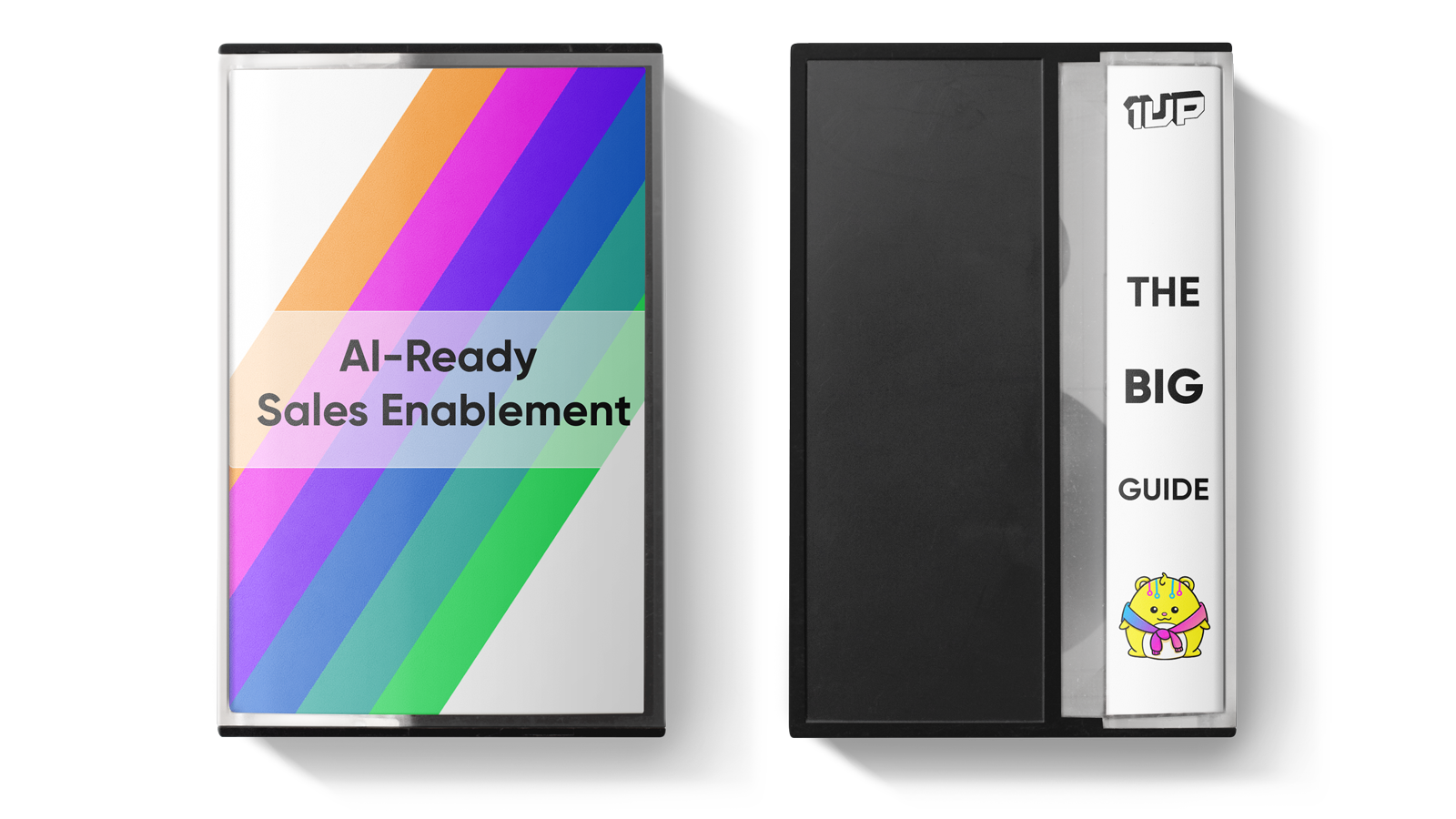It’s here. Your definitive guide to Revenue Operations.
Growing revenue isn’t just about stuffing more leads into a pipeline and hoping for the best. Too often, your marketing, sales, and customer success team will each operate in their own silos, leading to misalignment, inefficiencies, and missed opportunities. When data is scattered and teams aren’t working toward the same goals, predictable revenue growth becomes almost impossible.
That’s where Revenue Operations (RevOps) comes in. A well-structured RevOps plan brings everything together – people, processes, and technology to create a seamless, scalable system for maximizing revenue.
This RevOps guide will walk you through the fundamentals of RevOps, from aligning your sales and marketing teams to optimizing pipeline management and tech stacks. If you’re tired of reactive strategies and want a clear path to sustainable revenue growth, you’re in the right place.
Key Takeaways
- Getting your tech stack right is key – and that means more than just spending budget. Investing in automation upfront pays massive dividends down the line.
- Pipeline management is one of the first things to get right out of the gate. Don’t be afraid to revamp this if you’re starting in a new org, and be ready to make tweaks along the way.
- CRM hygiene is only part of the equation. Rather than chasing down reps who didn’t update Salesforce, focus on data quality instead. Accurate bookings, conversion metrics, and forecasting will help build predictability in your funnel.
Who is this RevOps guide for?
RevOps is about creating alignment and efficiency through people, processes, and technology to maximize revenue growth. A solid RevOps function enables companies to do more with less while providing visibility and accountability across all go-to-market teams.
Although RevOps is a function that wears many hats and has a broad scope of responsibilities, its day-to-day management is typically delegated to a sole person or small RevOps team. Regardless of size, the scope of RevOps responsibilities doesn’t change.
Broken up into six essential parts, our RevOps guide has been designed to walk these Revenue Operations teams through operationalizing and scaling their revenue operations.
- The sales playbook
- CRM architecture
- Territory planning
- Pipeline management
- The technology stack
- RevOps enablement
Although each component plays a different role, they work together to ensure that your revenue generation becomes more predictable and formulated by eliminating random chance.
Why has Revenue Operations become so important?
The numbers don’t lie – the RevOps function has become the backbone of every mature sales org.
Revenue operations include all business processes that kick into action from when a prospect shows an interest in your product until the organization realizes revenue from that purchase. These processes span across marketing, sales, and customer success functions.
In other words, RevOps encompasses an organization’s sales and marketing, contracting, ordering, billing, and renewal processes. It has an overarching focus on optimizing the customer experience by breaking down silos between different teams.
Although most organizations have well-established revenue teams, revenue operations is an integrated process that can be difficult to master. However, when RevOps is robustly managed, it can play a pivotal role in improving sales ops productivity and effectiveness.
This massive RevOps guide will cover all of the most important things you need for RevOps.is massive RevOps guide will cover all of the most important things you need for RevOps.
It takes products & process
RevOps bridges the gap between your CRM and ERP, but software tools only provide the foundation. What matters is how you build on it to implement a seamless process for increasing revenue generation.
Abigail Runner, Global Head of RevOps
Part 1: The sales playbook
Your sales playbook is the number-one, most crucial resource. Period. It outlines all your best practices, processes, and procedures for engaging customers at every touchpoint and closing deals in any selling situation.
By using the playbook as a guide, your revenue teams can improve their productivity, increase win rates, and drive revenue growth, all while reducing help desk requests and providing more time for proactivity. It can also be used as a training guide when onboarding new hires.
Building a solid sales playbook should be your first step in aligning your revenue teams and beginning your RevOps journey. What you include is down to you, but we recommend including the following elements.
Your sales process (with qualification methodology)
A well-defined, repeatable sales process is the cornerstone of the sales playbook. It tells your sales talent how to win and, more importantly, when to walk away to save resources. A repeatable process also lends itself to data integrity and continuous improvement.
Each phase in the sales process should include:
- A sales stage name
- A forecast stage name
- Critical activities for all go-to-market teams
- Customer-verifiable outcomes
Customer-verifiable outcomes are significant because they enable sales reps to qualify the opportunity based on what the customer is doing at that stage. The deal isn’t ready for the next stage if a rep cannot confirm outcomes.
Your sales process will evolve as the market changes, so be prepared to revisit and reevaluate at least once yearly in case you need to switch things up (i.e., following your sales kick-off).
Need a starting point? Download our free template for a Milestone-Driven Sales Playbook:
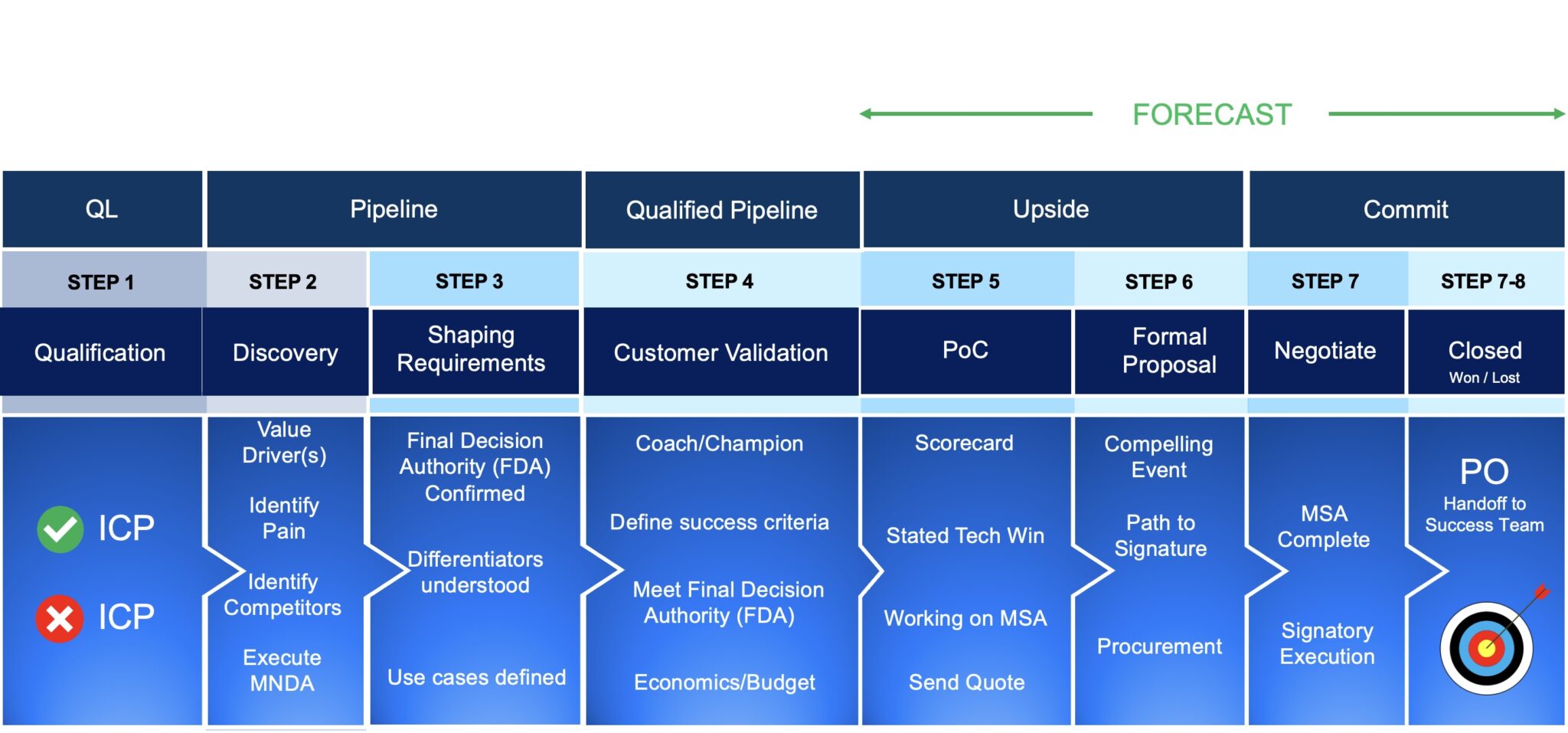
Your blueprint for success
Your sales blueprint sits alongside your sales process and sets out the goals you must achieve.
These goals can be set by asking yourself quantifiable questions such as, “To achieve our quota of $X million, what do we need to do?” It could be that you need to have Y meetings per week, generate Z% new qualified opportunities, or achieve a higher average deal size.
Your blueprint should also include a 360-degree pipeline generation plan focusing on reaching your target audience through multiple channels. You can put this plan together by working with:
- The marketing function
- Growth teams
- Business development
- Third-party reps and channel partners
Test out these goals in practice by creating a template in Excel or Google Sheets with locked-in formulas so sales reps can build their blueprints. For this to work, you’ll need to know data such as win rate, ASP, sales duration, and conversion rates.
As sales reps build their blueprints, analyze and optimize.If you don’t have it yet, use industry standards. Or check out our personal favorite, the GTM Planner from Unusual Ventures.
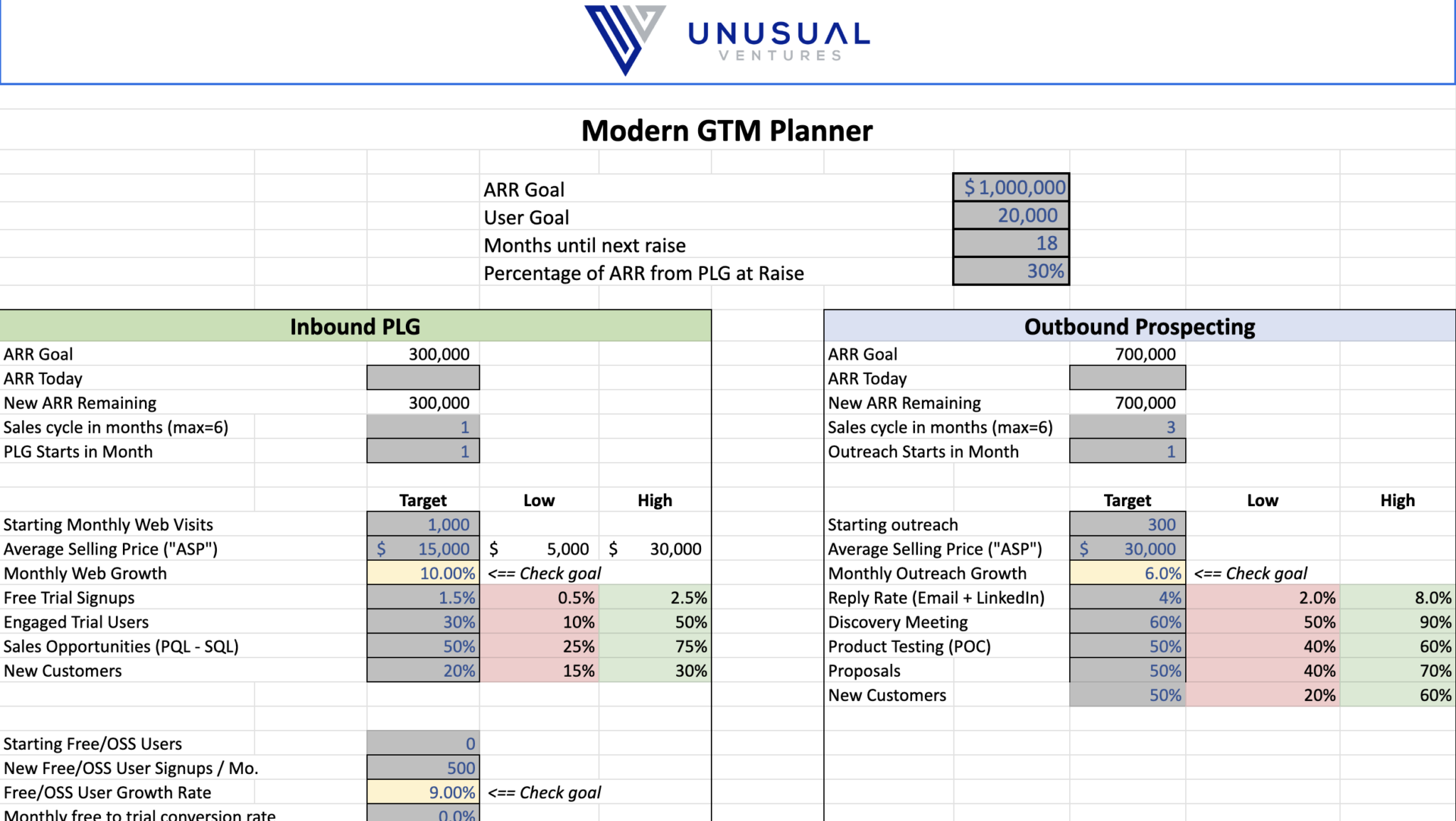
Sales enablement materials
Your sales teams might be well equipped to go out and start winning armed with an understanding of your sales process and a blueprint for success, but you can build on this further with various sales enablement materials.
A consistent buyer message, for example, allows your sales teams to articulate your product’s unique value proposition and align it with the needs of your target market. Meanwhile, competitive battle cards provide a reference point for quickly comparing your product’s facts, features, pricing, and other critical metrics to your competitors.
Don’t forget customer objections, either. These can be a sticking point for teams, but they can easily be overcome with the right approach to objection handling.
Lead flow management
Lead flow management helps to ensure the effective management of leads as they move through your sales funnel. This guarantees a consistently positive experience and increases the chance of converting them.
Solid lead flow management includes:
- Qualification questions to help you understand if the company will be the right product-market fit or if the role is the right person to take the call with. Examples include:
- Who makes purchasing decisions in your org?
- What problem(s) are you trying to solve?
- Why is now the right time?
- What have you tried in the past?
- Lead follow-up examples that are made available to sales reps, which can help them follow up with a lead following an initial discovery successfully. These can include simple tips and tricks or entire templates and scripts. Follow-up examples might include:
- Email templates
- Must-ask questions
- Timelines for following up
- When to push and when to stop
- Hand-off and CRM instructions, which are designed to walk your sales reps through the process of handing off a lead from one team to another. This ensures the correct information is passed to the right people at the right time and point in the sales process.
Pricing and quoting
Drawing up a pricing table for all your products and services is good practice. The more granular you can make this. For example, by pricing up different combinations with add-ons and extras, the easier it will be for sales reps to draw up a quote to present to potential customers.
Be sure to include things like discount options (i.e., multi-year, pay up-front), volume pricing options, seasonal pricing variations, partner pricing, and anything else that should be accounted for by your sales reps when preparing their quotes.
Account planning
Once a lead is in the process of converting, it’s time to think about account planning. You can think of a customer’s account as the central internal repository where you manage and develop your relationship with that customer.
Account planning aims to understand a customer’s business and foster a robust and long-term relationship to maximize the revenue potential over time. Account plans can include a wide range of information but will typically contain:
- A custom strategy designed to align sales with the customer’s needs.
- Clear objectives and metrics such as sales targets and satisfaction levels.
- A detailed action plan for attacking the account’s sales goals.
It’s also good to draw up a rough organizational chart of a customer’s top team to include in the account plan. This provides a quick point of reference for sales reps when it comes to identifying who they’re speaking to.
Legal process management
As you approach closing a deal, you must begin getting your paperwork in order. Drafting contracts, ensuring compliance with applicable laws and regulations, and risk assessments are just a few processes that are involved in a typical sales process. It’s vital to guarantee that your sales activity is legally sound.
- Contracts are critical documents in sales that outline the seller and buyer’s terms, conditions, and obligations. Effective contract management ensures that they’re accurate, fair, and watertight.
- Compliance ensures that your sales activities align with various laws and regulations, such as consumer protection laws and data privacy regulations. There will be other applicable regulations in industries like healthcare and finance.
- Risk management identifies, assesses, and seeks to mitigate risks associated with sales transactions. This might involve analyzing the legal implications of a deal or assessing customer creditworthiness.
Ensure that you have a robust pipeline for creating and managing legal documentation to ensure that it’s reviewed and signed by the right people at the right time.

Customer onboarding
The final step in the sales process is onboarding. At this point, sales teams need to start thinking about permanently handing the new customer over to other teams, such as customer services, who will help nurture the relationship going forward.
This is where swim lanes can be extremely valuable by acting as a visual tool to distinguish responsibilities, workflows, or actions of different departments or roles within the customer onboarding process. A good sales process diagram will clearly show where the customer services team is introduced to the sales cycle and answer questions like these:
- When does the CS team get introduced in the sales cycle?
- What’s their role with the customer in the sales process?
- Who sends the welcome email?
- What are CS responsible for vs. the pre-sales team?
It’s also important to consider what your CS team needs to onboard the customer and have a successful, seamless implementation.
Questions they need answers to might include:
- What has been purchased, by whom, and to what extent should it be implemented?
- Who are the key stakeholders?
- Has the customer purchased any particular support packages?
- Does the customer have any special feature requests?
- What are the contractual obligations?
Part 2: CRM architecture
CRM is one of a sales rep’s most important tools. Consequently, it’s also one of the most crucial components of RevOps. Despite its critical role, it can also be one of the most misunderstood and under-appreciated aspects of the sales function.
CRM data quality
A solid CRM begins with high-quality data and metrics. By intelligently storing and managing your data, CRM systems can:
- Increase your lead volume
- Support sales teams in closing deals faster
- Enhance customer service and experience
- Help your marketing team discover new customers
It’s no accident that data analysis is one of the core components of this function. Still, for data to be analyzed, it needs to exist and ideally be in a format easily digested for information extrapolation.
Begin by taking stock of your current data and identifying the work needed to refine your data infrastructure. If you don’t have any data, identify the work required to start collecting it.
Once you’ve done your analysis, create a timeline with realistic deliverables to give your leadership team an idea of what to expect and when.
This will put them in an optimal position to budget for the resources they need to begin extracting actionable insights from organizational data (or, if your organization lacks data, to start collecting it.)
Getting started
The best starting point is to identify key revenue metrics that the finance function needs to report on because this is the most valuable data to measure against stated goals. The metrics that you’ll want to implement into your CRM tool early on include:
- Annual Recurring Revenue
- Total Contract Value
- Deal Type (Initial, Expansion, Renewal)
- Bookings
You’ll also want to know the closed-lost reasons behind any opportunities and marketing qualified leads that have failed to convert. Knowing why these people didn’t buy your product is not only helpful for nurturing other prospects further down the line but can also identify trends so that go-to-market and sales enablement strategies can be optimized.
In addition, set up your CRM for:
- Tracking leads and conversions
- Managing customer interactions across different touchpoints
- Good hygiene, through alerts and notifications
- Close dates in the past
- Sales stage duration exceeds a specified period
- Close date too early for sales stage
- Unconverted leads
- Upcoming renewals
To avoid the classic issue of, “If we can’t see it in the CRM, then it doesn’t exist!” make sure you align your sales process and methodology with your CRM tool and capture all critical fields in the sales opportunity. Favor generic sales stage names over unique ones to ensure that it’s easier to perform analysis in the future.
When setting up your CRM system, keep user experience top of mind. Keeping your system clean by only including critical data fields helps to make it easy to use, which lends itself to engagement and adherence to best practices by your sales reps.
Suppose you’re reading this and feel unsure about converting our tips into actions. In that case, it might be worth considering working with an experienced consultant who can help establish a solid foundation for your CRM.
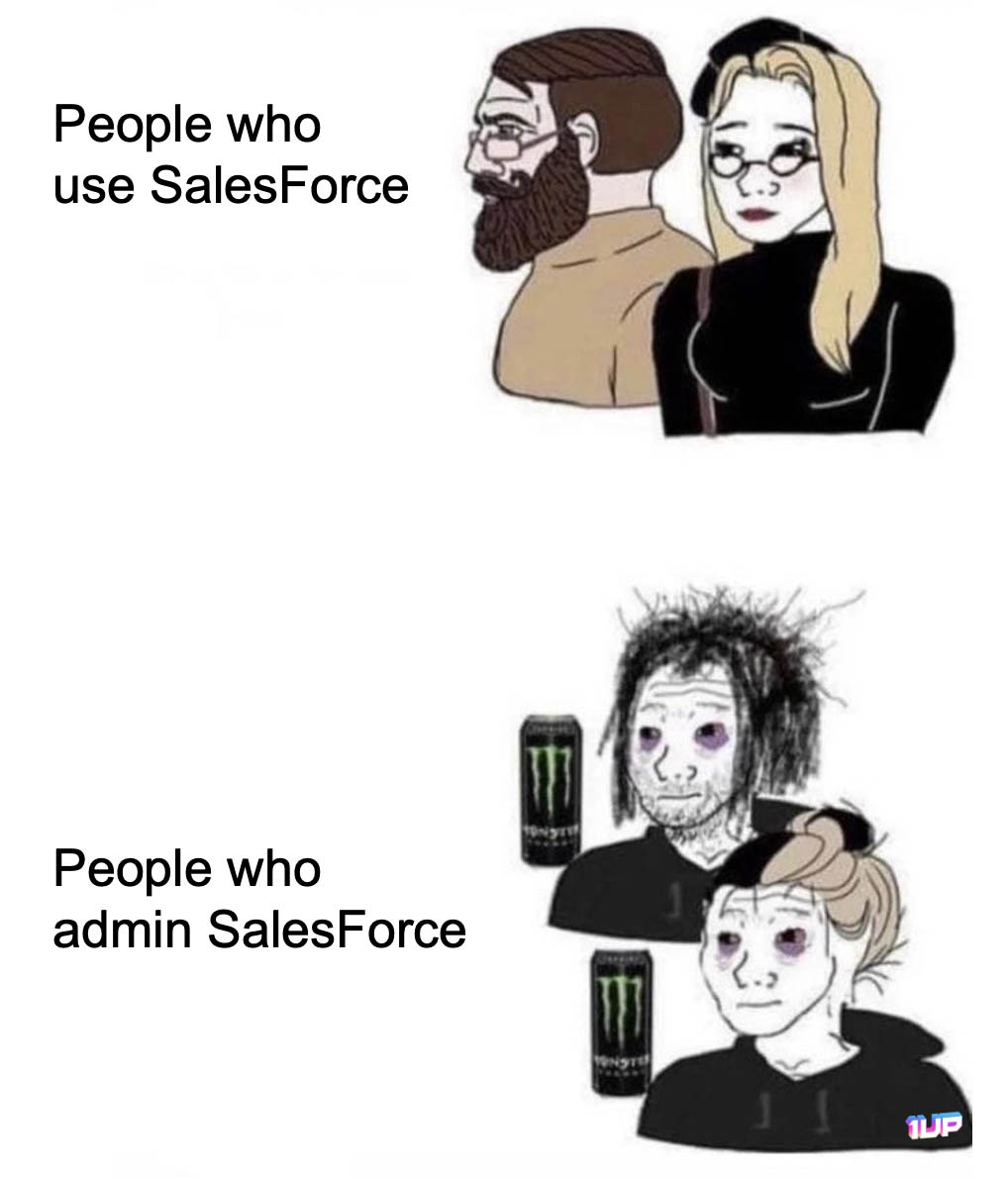
Part 3: Territory planning
Whether you have a team of two sales reps or a team of two dozen, it’s essential to clearly define market segments and set regional territories for each representative. This is known as territory planning, and as a process, it’s used to point to a specific geographic region, industry sector, or set of accounts that a sales rep focuses on.
Territory planning can help to:
- Improve productivity by narrowing down rep focus areas for better account planning
- Improve lead management flow
- Streamline cross-functional alignment across different revenue teams
- Manage territory and account reassignments as sales teams scale
- Optimize hiring and focus resources on the right areas
Building your territory plan
Define your goals
First, you’ll need to define your territory planning goals. Goals will naturally vary by business, but they will usually focus on revenue, market share, and product or service-related metrics.
If, for example, your goal is to increase your market share, you need to know where you are likely to have the most success and focus your efforts on the right geographies. One way to do this is by defining your ideal customer profile, the “perfect customer” for whom your product or service is ideally suited.
We’ll cover ideal customer profiles in more detail shortly.
Identify the best regions
You’ll then need to identify the best regions for your sales reps to focus on. These regions will be the areas that (i) you have a presence in and can reach with your product or service and (ii) have the highest concentration of your ICP accounts.
Compare these regions
After you’ve identified your best regions, you’ll need to narrow them down to a volume that’s manageable by your current team. Compare your most dense regions (i.e., those with the most accounts) against your current team’s capabilities and location, and assign evenly distributed territories. Avoid biting off more than you can chew.
Create target lists
You should build suggested target account lists when determining which regions will be your top focus areas. These lists include your ideal prospects that are most likely to convert. Focusing on these helps your reps narrow their focus during outbound efforts and prioritize quality over quantity.
Provide your reps with a curated list of suggested target accounts within their respective regions. This enables them to focus their efforts on selling to the correct accounts. This is particularly important for smaller teams working in large territories.
Identify coverage gaps
By the end of your territory planning, you’ll probably have several regions where no reps are assigned despite the existing opportunities. These represent gaps in your go-to-market coverage, and you should use them as a guide for where to hire additional sales reps or move your resources to if any regions are oversubscribed.
Your ideal customer profile
An ideal customer profile (ICP) is a hypothetical description of the type of company that would derive the most value from your product and service. Consequently, those that fit your ICP are the most desirable clients for your business.
Your ICP helps focus sales and marketing efforts more effectively by identifying and targeting the businesses that are most likely to buy, have the longest lifetime value, and have the greatest potential for successful partnerships.
The most effective step in developing your ICP is to define how it looks from a firmographics perspective by answering these questions:
- What industries does our ideal customer operate in?
- What’s our ideal customer’s annual revenue?
- How many employees does the company have?
- Does it matter where our customer is geographically located?
- If so, what’s their ideal location?
You might also want to consider other attributes, such as:
- Does our ideal customer have a mature tech stack? Is this necessary?
- Does our ideal customer have competition, or are they in a niche market?
- What does our ideal customer’s buying process look like?
Not sure what these sales terms mean?
Don’t worry, most people don’t. That’s why we created the Sales Encyclopedia.
Buyer personas
Developing buyer personas is another important step in developing your ICP. While your ICP outlines the perfect company for your product or service, the buyer persona represents the people within an organization you sell to. In other words, they’re the people who make buying decisions.
It’s crucial that you take time to do your research and develop solid personas based on data and market research that your reps can rely on.
- Identify specific job roles and functions of influential individuals
- Understand their specific needs, challenges, and pain points
- Identify their professional objectives and drivers
- Understand how they make purchasing decisions
- Determine their preferred channels for receiving information and communication
- Outline the steps that they take from discovery to conversion
- Use insights from sales reps about their interactions with actual buyers
Product-market fit
In addition to your ideal customer profile, you must know your product-market fit when building and optimizing a territory plan.
Product-market fit describes the degree to which a product can meet a market’s overall demand. It’s an essential metric for determining whether a product can solve a real customer problem.
Think about it this way: Your reps simply cannot target and sell to new accounts if they don’t know (i) who the ideal customer is and (ii) whether what they’re selling is a good fit for their market.
Consider the following when developing a product-market fit:
- Who the product is for, and the buyer’s needs and challenges
- That the problem you’re solving is significant and widely experienced
- Market size and accessibility – there needs to be enough demand
- Your competitors and how your product is different
- Whether your product aligns with current and emerging market trends
Although territory planning will never be perfect or on-target 100% of the time, developing a solid ICP and product-market fit can help you get as close to the mark and the market as possible.
Part 4: Pipeline management
One of the most common complaints we hear from one RevOps leader after another is that there are a lot of deals in the pipeline. You might be thinking, “Why would they complain about that!?” To understand this, context is key.
Your sales pipeline visually represents where your prospects are in the sales process. When managed right, it can unlock valuable insights, such as indications of which deals are likely to close, when they’re likely to close, and which of your reps are hitting their targets.
In contrast, when a sales pipeline is chock-full of deals without a strategy for analysis or cutting through the noise, it can be impossible to separate the wheat from the chaff. For example, the deals worth focusing on vs. those that are unlikely to close.
Segmenting your sales pipeline
The best way to do this is by implementing a well-defined sales process with pipeline stages that have straightforward entry and exit criteria. This will significantly improve your data quality and forecast accuracy. The specifics of your pipeline stages and entry/exit criteria will depend heavily on how your sales function works, but here’s a general example.
1. Lead generation
The first stage of the sales pipeline is generating leads. Lead generation can take many forms, but it typically involves building interest in your product or service among your target audience to get people on the hook.
Naturally, there’s a low threshold for a prospect entering this stage of the pipeline, such as:
- Visiting your website
- Submitting their details via a contact form
- Attending a webinar
Since all leads need to be scored, there’s a similarly low threshold for exiting this stage:
- Picked up by a sales rep for lead scoring
- Marked ‘unqualified’ for failing to meet certain criteria
2. Lead scoring
Lead scoring is a method sales and marketing teams use to determine the worthiness of leads and identify those that hold the most value.
This is achieved by awarding values or “points” to leads based on their behavior and whether they meet specific criteria, such as fitting your ideal customer profile or being from a target industry.
Once a lead achieves a certain number of points as determined by you, they’re deemed as ‘qualified’ and can move on to the next stage. For example, visiting your website may earn +80 points, submitting their details via a contact form +40 points, and attending a webinar +70 points for a total of 190 points.
If your threshold is 150 points, then they’re ready to move to the next stage.
Exit criteria:
- Surpassing your lead score threshold.
You want to ensure your team is spending their time effectively. Lead scoring will prevent your team from chasing unqualified leads.

Yeah, we’ve been there. Check out our favorite RevOps memes.
3. Lead interaction
Lead interaction is any engagement or communication between a sales rep and a lead during the sales process.
They are crucial components of the lead nurturing and sales processes, aiming to build relationships, assess needs, provide value, and ultimately guide leads toward purchasing decisions.
Lead interactions can occur across various customer journey stages, from initial awareness to consideration and decision-making.
Exit criteria:
- The lead has asked for a product demonstration
- The lead is showing palpable interest in your product offering
- Lead interactions have taken place more than once
- The lead has reached out to you directly
- The lead meets your ideal customer profile
4. Value proposition
This stage of the sales pipeline allows your sales reps to tell your lead why they should choose your product or service offering. A strong value proposition should communicate the benefits in a way that’s easy to understand.
Exit criteria:
- The lead has agreed in principle to buy your product or service
- The lead is trying or has tried to negotiate with a sales rep
5. Negotiation
Negotiation is the process of reaching an agreement between the sales rep and the lead on the critical terms of a deal, including price, delivery, and other conditions of sale.
It’s a critical stage in the sales pipeline where both parties discuss their needs, constraints, and preferences with the aim of finding a mutually beneficial solution that leads to closing the deal.
Exit criteria:
- Negotiations have concluded, and an agreement is in place with documents signed
6. Conversion and hand-off
Conversion is the final stage in the sales pipeline. It’s when your lead officially becomes a customer by finalizing their purchase of your product or service. Although the sales job is pretty much done here, they still need to be managed and followed up on, so they should be handed off to customer services, who will manage them via their workflows.
Exit criteria:
- The lead has converted, payment has been received, and the lead is now a customer
Tips for success with your pipeline management
Establish hygiene rules
Implementing hygiene rules and guardrails for sales reps to follow will help ensure your sales pipeline stays current and healthy. These rules might include timely updates of deal statuses, regular cleaning out of stale or inactive leads, and accurate recording of interaction notes and next steps. Hygiene rules minimize clutter, reduce the risk of overlooking promising opportunities, and help reps make decisions based on reliable data.
Create stakeholder dashboards
Different stakeholders require varying levels of detail and focus to support their roles. As such, it’s a good idea to create custom dashboards for various stakeholders and schedule automatic reports that only include the data points that are relevant to them. For example, a dashboard for sales reps might emphasize upcoming tasks, deal progress, and activity metrics, while managers’ dashboards could focus on team performance, pipeline health, and forecast accuracy.
Focus on lead scoring
Lead scoring is the most essential step in any sales pipeline. It’s vital for effective pipeline management because it ensures that subsequent sales efforts are concentrated on leads with the highest potential for conversion.
Sales teams should adopt a structured approach to qualify leads, using criteria that may include the lead’s budget, authority, need, and timeline (BANT) to assess their readiness and fit for the product or service offered. This enables sales teams to allocate resources more effectively and improve overall pipeline health.
Automate, Automate, Automate!
Incorporating the proper tooling into your sales pipeline management can significantly increase the insights you’re able to pull from it. Streamlining data entry, lead tracking, and follow-up tasks are just a few examples of how technology can free up sales reps to focus on more value-driving tasks and make better decisions.
One recent example is automating responses to RFPs and sales questionnaires:re just a few examples of how technology can free up sales reps to focus on more value-driving tasks and make better decisions. One recent example is automating responses to RFPs and sales questionnaires:
Part 5: The technology stack
Building out a RevOps stack is a must-do for teams of one and one hundred. Choosing the right tools, however, is a lot like a puzzle. You need to find the right pieces that fit together to build the bigger picture: functional and efficient revenue operations.
Many teams approach this task by acquiring every tool under the sun. This approach might work for a little while but will eventually bring things to a grinding halt as RevOps becomes bloated and difficult to maintain. Instead, we recommend carefully selecting the tools you need in the short term and understanding nuances like implementation timelines, integration requirements, and the level of customization required.
Core components of a lean RevOps tech stack
Customer Relationship Management
CRM is the most crucial tool in any RevOps tech stack. It helps your reps manage all interactions with current and prospective customers, with the overarching goal of improving business relationships, helping companies stay connected to customers, streamlining processes, and improving win rates. When applied to Revenue Operations (RevOps), CRM plays a crucial role in aligning sales, marketing, and customer service processes and goals.
Examples of CRM tools include Hubspot, Salesforce, PipeDrive, and Monday.
Marketing Engagement
Marketing engagement tools are designed to create, manage, and measure engaging marketing campaigns across various channels. These tools are pivotal in orchestrating personalized customer journeys, automating marketing tasks, and providing data insights to align marketing efforts with sales and customer service goals, thereby driving revenue growth. Ensuring that your marketing engagement tool integrates with your CRM for maximum effectiveness is vital.
Examples of marketing engagement tools include Hubspot, Marketo, and Drift.
Account Sales Intelligence
Account sales intelligence platforms empower sales, marketing, and customer success teams with actionable insights and data on prospective and existing accounts. These platforms facilitate a strategic approach to sales and marketing by providing comprehensive, accurate, and up-to-date information about businesses and their key decision-makers, enabling personalized and informed engagement strategies.
When used correctly, they become a workhorse for marketing operations, sales, business development, and sales reps by bolstering a wide range of workflows, including:
- Territory planning
- Target account planning
- Lead to account matching
- Prospecting
- Account intelligence
Examples of account sales intelligence platforms include Zoominfo, Apollo, and Leandata.
Partner Portal
Partner portals are ideal tools for businesses with limited resources. They streamline the interaction between the company and its partners and provide resources, tools, and information needed to sell products and services to target markets. They can be instrumental in nurturing relationships with channel partners, affiliates, resellers, or any third-party vendor involved in the sales and distribution process.
One piece of advice worth mentioning is that you don’t want to implement this too early. A successful partner program will often require a mature product, sales process, and dedicated team behind it. Focus on these key elements before throwing software at the challenge.
Examples of partner portals include Zendesk and Impartner.
Customer Engagement
Customer engagement tools enable service and experience teams to interact with customers across various stages of their journey, from awareness to purchase and beyond, to build and nurture positive relationships and experiences. These tools are critical in aligning marketing, sales, and customer service efforts to drive growth and enhance the overall customer experience. We recommend waiting until you’ve got a customer support team in place before implementing a fully-fledged engagement tool; they’re best placed to help set up and manage it.
Examples of customer engagement tools include Gainsight and Zendesk.
Knowledge Automation
Knowledge automation tools leverage enterprise search, machine learning, and natural language processing to automatically provide sales reps with instant access to the information they need when they need it. Whether you require a detailed technical explanation or a simple 2-liner for a cold call, these tools are design to deliver answers to complex queries in seconds. These tools are often integrated with messaging platforms such as Slack and Microsoft teams for easy access.
Examples of knowledge automation tools include 1up, Elastic, and Guru.
Want more 🔥 posts like this?
Subscribe to our blog for early access to content like this.
Part 6: RevOps enablement
Sales enablement can be a huge sales productivity booster when appropriately done. Still, despite it being a relatively simple concept, it can take time for smaller teams to get to grips with it. That’s because there’s a tendency for teams to overcomplicate matters and let enablement run away from them.
Think of sales enablement as equipping reps with what they need to engage and sell to buyers. That’s it. The most effective enablement programs harmonize marketing and sales to increase revenue, shorten the sales cycle, and improve conversion rates.
We believe it’s easier to approach sales enablement by breaking it into three main areas: i) new hire onboarding, ii) sales strategy training, and iii) product knowledge.
New hire onboarding
Solid sales enablement begins with a new hire onboarding program that sets people up for success with the knowledge, skills, and tools they need as they enter the organization.
Effective onboarding goes beyond mere introductions to company policies and procedures. It immerses new hires in the company culture, product knowledge, sales processes, and best practices from day one. This stage is critical for ensuring that sales representatives are well-equipped to understand customer needs, articulate value propositions clearly, and navigate sales cycles efficiently.
A well-structured onboarding process accelerates the time it takes for new salespeople to become productive team members, directly impacting sales performance and revenue growth.
By integrating practical training sessions, your sales playbook, and hands-on experience with the revenue enablement technology stack across a structured training schedule, sales teams can foster more engaged, confident, and capable reps. With regards to new hires, the use of sales enablement AI is becoming more popular as a means of automating answers and asset delivery.
This process isn’t a one-and-done situation. Make sure to supplement it with regular check-ins, activities, pipeline goals, and opportunities for certifications and upskilling. Additionally, look at ways to reduce onboarding time by automating sales coaching in the field:
Sales strategy training
Sales strategy training equips sales reps with the strategic insights and skills to navigate their roles effectively. It is best delivered as part of a structured training schedule that explores different sales process components one by one. Work with leaders and cross-functional teams to develop a schedule that includes:
Sales messaging: Ensuring that sales representatives can communicate the company’s value proposition clearly and compellingly, tailoring their messaging to resonate with different target audience segments. Keep reps engaged by making the training interactive and competitive.
Sales skills: Enhancing core sales competencies, such as prospecting, negotiation, closing techniques, and relationship building, to improve sales performance. Include a particular focus on:
- Understanding the buyer, their day-to-day problems, and goals
- Sales qualification methodologies, building champions, and MEDDICC
- Qualification questions
Competitive landscape: Providing deep insights into the market, including key competitors, their strengths and weaknesses, and how to position the company’s offerings as the superior choice.
Objection handling: Preparing sales reps to anticipate and address common customer objections, turning potential deal-breakers into opportunities for reinforcing the product or service’s value. Consider using a tool like 1up to help reps automate customer objection handling.
SPIFF programs: Introducing incentive programs designed to motivate and reward sales teams for achieving specific goals, driving engagement, and fostering a high-performance sales culture.
Win stories: Sharing real-life success stories of how sales representatives have successfully closed deals, highlighting the strategies, tactics, and best practices that led to those victories. This serves as a motivational tool and provides actionable insights and lessons that the entire sales team can apply to replicate similar successes in their sales efforts. Encourage reps to share their stories by creating a win story template that includes:
- Deal summary
- Customer pain points (and how we solved them)
- Challenges encountered (and how we overcame them)
- Major stakeholders involved and what was important to them
- Sales tactics that helped to seal the deal.
Here’s a free WinCast template you can use to share success stories with your team:
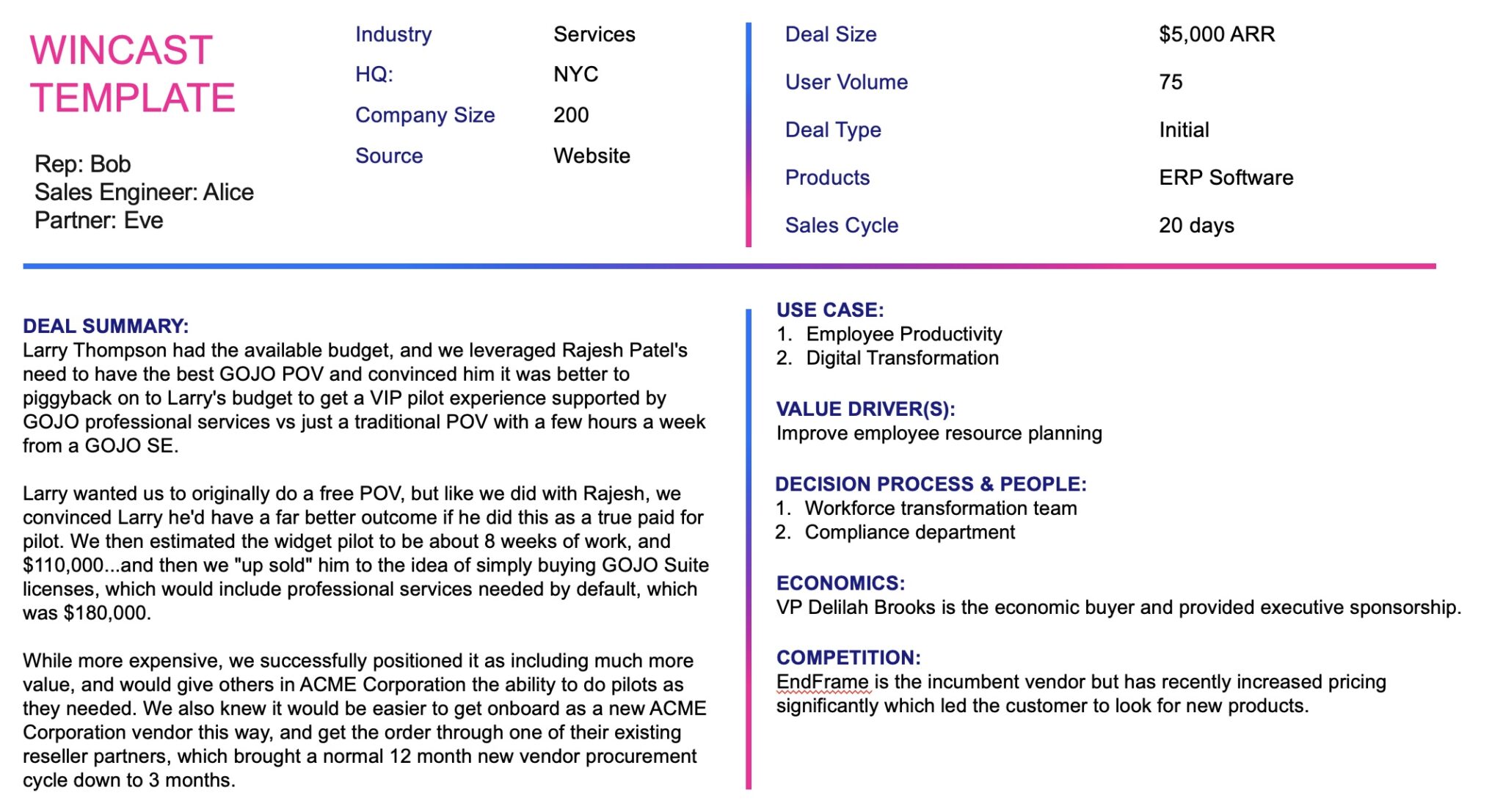
Product knowledge
Your sales reps can’t sell your product effectively if they don’t know enough about it. Conversely, sales reps equipped with in-depth product knowledge are seen as credible sources of information. This credibility fosters trust with potential customers, a crucial element in sales.
Understanding the nuances of a product also enables sales reps to tailor their conversations to each prospect’s specific needs and pain points, making interactions more relevant and impactful to increase the chance of converting.
You can take various approaches to equip your sales reps with product knowledge. Training goes a long way, as does shadowing senior reps on customer demo calls. Still, at 1up, we think the most straightforward approach is to supplement training with knowledge automation, enabling any rep to answer technical sales questions.
To supplement product training, ensure you have a central repository for all sales assets and training materials that are easily accessible. The best repository makes it easy for reps to dip in, run a search query, and find what they’re looking for there and then. Access should be controlled so only content owners can upload or edit content to help manage version control and assurance.
A good example would be using Confluence to store product knowledge and making it accessible to the sales team.
Wrapping up
When done right, the RevOps function is the backbone that keeps your revenue generation operations standing and running smoothly to ensure long-term growth.
We appreciate that there’s a lot to digest in this ultimate guide to Revenue Operations. At the same time, there’s still a lot we haven’t covered in detail.
So here are a few frequently asked questions about RevOps:
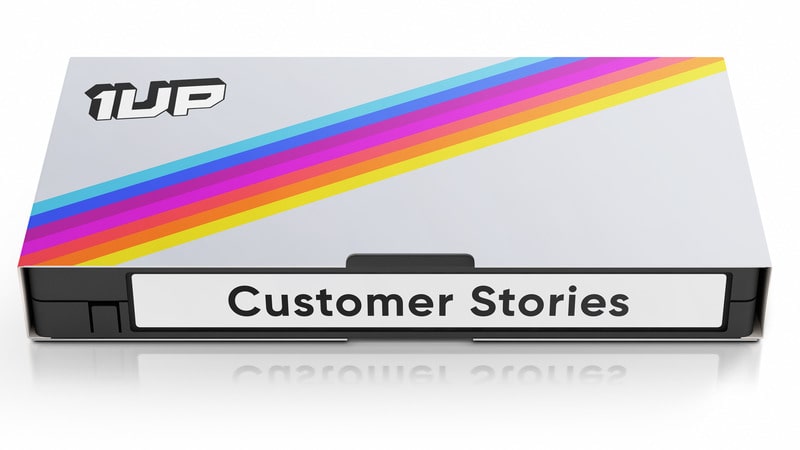

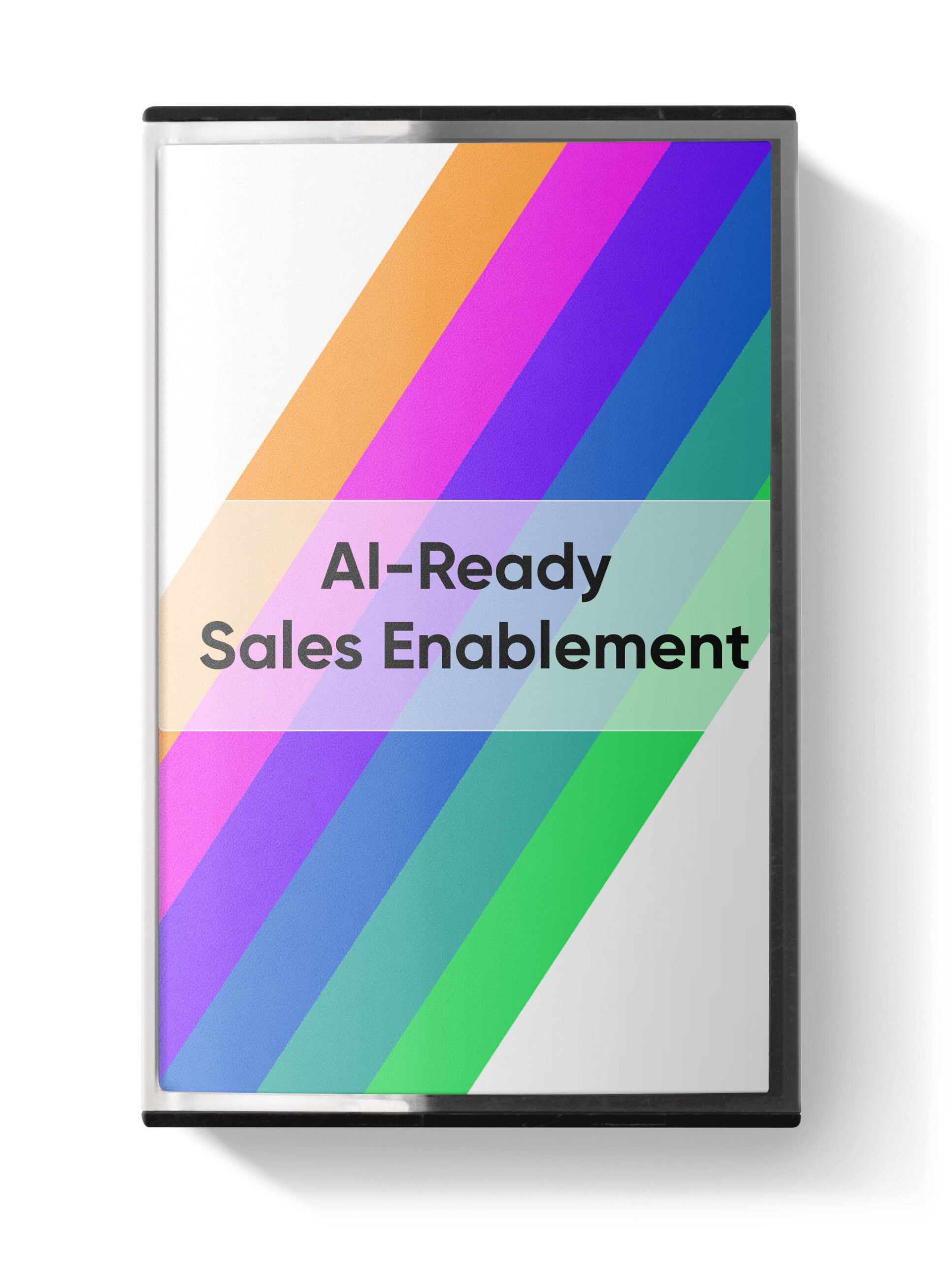
 Instagram
Instagram 


